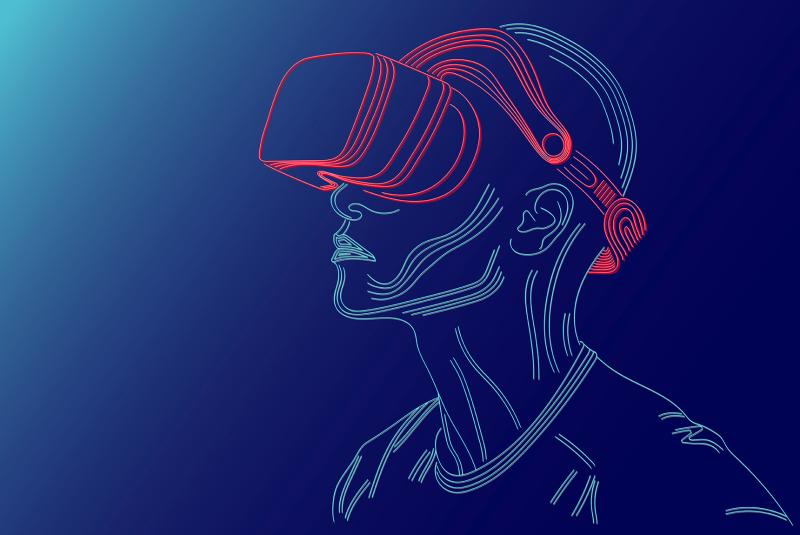Virtual Reality (VR) and Augmented Reality (AR) are two immersive technologies that have transformed our interaction with digital content. Despite their similarities, they have distinguishing characteristics that set them apart. Virtual reality (VR) refers to the total immersion of users in a computer-generated environment, which replaces the actual world. This is accomplished through virtual reality (VR) headsets, which generate a 360-degree, three-dimensional environment that isolates users from their real surroundings. VR applications include, among others, gaming, training simulations, and virtual tourism.
AR augments reality by superimposing computer-generated images, audio, or data onto the user’s field of view. Typically, AR-capable devices, such as smartphones, tablets, and smart eyewear, accomplish this. AR applications range from navigation assistance and real-time information display to interactive gaming and educational experiences. The primary distinction between virtual and augmented reality is their relationship to the real world. AR increases the user’s reality with digital information, whereas VR creates a wholly virtual environment for users to explore. AR, conversely, incorporates digital elements into the user’s actual environment. Both technologies have enormous potential to transform numerous industries and improve user experiences.
What is Virtual Reality (VR)?
Virtual reality (VR) is an immersive technology that creates a computer-generated, three-dimensional experience that users can explore and interact with. When users put on special headsets with motion sensors and screens, they are taken out of their natural world and into a virtual one. These VR headsets track the user’s head movements and change the pictures they show to make the experience smooth and real. Extra items like handheld controllers, gloves, or suits with motion sensors are often used to improve the connection and let users do things in the virtual world.
VR can be used in many different ways in many different fields. It gives gamers a level of realism that is unmatched, making them feel like they are in the game. VR can make learning more immersive in education by letting students explore historical places or experiment in virtual labs. VR is used in health care for therapy, rehabilitation, and training doctors and nurses through accurate simulations. VR also helps other industries, like building, automotive, and aerospace, with prototyping, designing, and training in a virtual world. In the end, Virtual Reality is a powerful tool that puts people in simulated environments that are rich and interesting. It can be used in many ways that could change many fields, from entertainment and education to healthcare and building.
What is Augmented Reality (AR)?
Augmented reality (AR) is a technology that adds digital information to a user’s real-world surroundings to make the experience more interactive and exciting. AR combines the digital and real worlds so that users can experience both simultaneously. This differs from Virtual Reality, which puts users in a completely virtual setting. AR is usually viewed through smartphones, tablets, or smart glasses. These devices use cameras, sensors, and software to recognise and analyse the user’s surroundings and then show relevant digital information, pictures, or animations on the screen or display. As users move around or interact with their environment, the digital material changes in real time, making it look like it has always been there.
AR can be used in many different ways and many different fields. AR can be used in retail to create virtual fitting rooms or product visualisations that let customers try on things before they buy them. AR helps people learn by giving them interactive and contextual information, like showing 3D models of historical artefacts or making complex ideas easier to understand. AR can add directions or places of interest to the user’s view, making it easier to find your way. AR is also used in the entertainment, games, and industrial fields for maintenance, training, and visualising designs. In short, Augmented Reality is a new technology that improves the user experience by adding digital material to the real world. It has unique and interactive uses in many different industries.
Difference Between Virtual Reality and Augmented Reality
There is a fundamental difference between VR and AR in how they interact with the user’s actual surroundings. Virtual reality (VR) transports people out of their actual bodies and into a simulated, computer-generated environment. Virtual reality hardware and accessories make this possible. By superimposing digital content, such as images, sounds, or information, onto a user’s perspective of the physical world, augmented reality (AR) enhances the user’s real-world experience. Devices like smartphones, tablets, and smart glasses are used to interact with AR. The difference between virtual reality and augmented reality is that the latter adds digital aspects to the real world. The primary distinctions between virtual reality and augmented reality are mentioned here.
Immersion
In contrast to AR, which adds digital elements to the real world, VR allows users to immerse themselves entirely in a simulated environment.
Devices
Unlike augmented reality (AR), virtual reality (VR) requires no special hardware or peripherals to interact with.
Isolation
In contrast to augmented reality, virtual reality (VR) completely removes users from their surroundings.
Interaction
Unlike augmented reality interactions, virtual reality ones occur entirely in a simulated setting.
Applications
Games, simulations, and other virtual experiences are common uses for VR, while navigation, information display, and different context-aware experiences are the focus of AR.
Content Creation
AR content can be more straightforward and overlay existing surroundings, while VR content development requirements are higher.
Connectivity
While virtual reality experiences can be enjoyed without an internet connection, augmented reality experiences typically require a constant data stream.
Adoption
Although virtual reality (VR) is becoming increasingly popular, augmented reality (AR) is more widely used because it can be accessed on more mainstream devices, such as smartphones.






